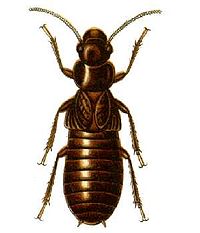- Mastotermes
-
Giant Northern Termite 
Scientific classification Kingdom: Animalia Phylum: Arthropoda Class: Insecta Subclass: Pterygota Infraclass: Neoptera Superorder: Dictyoptera (see text) Order: Isoptera Family: Mastotermitidae Genus: Mastotermes Species: M. darwiniensis Binomial name Mastotermes darwiniensis
Froggatt, 1897Mastotermes darwiniensis, common names Giant Northern Termite and Darwin Termite, is a termite species found only in northern Australia. It is a very peculiar animal, the most primitive termite alive.[1] As such, it shows uncanny similarities to certain cockroaches, the termites' closest relatives. These similarities include the anal lobe of the wing and the laying of eggs in bunches, rather than singly. It is the only living member of its genus Mastotermes and its family Mastotermitidae, though numerous fossil taxa are known. The termites were traditionally placed in the Exopterygota, but such an indiscriminate treatment makes that group a paraphyletic grade of basal neopterans. Thus, the cockroaches, termites and their relatives are nowadays placed in a clade called Dictyoptera.
These singular termites appear at first glance like a cockroach's abdomen stuck to a termite's fore part. Their wings have the same design as those of the roaches, and its eggs are laid in a case as are roach eggs. It is thought to have evolved from the same ancestors as the wood roaches (Cryptocercus) in the Permian. Fossil wings have been discovered in the Permian of Kansas which have a close resemblance to wings of Mastotermes of the Mastotermitidae,[2] which is the most primitive living termite. This fossil is called Pycnoblattina. It folded its wings in a convex pattern between segments 1a and 2a. Mastotermes is the only living insect that does the same.[3] Unlike roaches not all termites have wings: Only the reproductives, (see Termites-life cycle) whose wings are considerably longer than their abdomen. Mastotermes darwiniensis is usually not very numerous, nor are the colonies large when left to natural conditions. However, when given abundant water(such as regular irrigation) and favourable food & soil conditions (such as stored timber or timber structures), populations can be enormous, numbering in the millions, quickly destroying their host. Its diet is varied, as it will eat introduced plants, damage ivory and leather, and wood and debris, in fact almost anything organic. It becomes a major agricultural pest, to the extent that vegetable farming has been virtually abandoned in Northern Australia[4] wherever this termite is numerous, which it is outside of the rain forest or bauxite soils.[5] It has developed the ability to bore up into a living tree and ring bark it such that it dies and becomes the center of a colony.
Mastotermes darwiniensis is the only known host of the symbiotic protozoan Mixotricha paradoxa, remarkable for its multiple bacterial symbionts.
Fossil record
There have been numerous fossil taxa described in the Mastotermitidae as well as in the genus Mastotermes. The family seems to have had a worldwide distribution until just a few million years ago, when all but the ancestors of the Giant Northern Termite became extinct for unknown reasons.
Prehistoric Mastotermitidae genera are:
- Blattotermes
- Miotermes
- Spargotermes (Miocene-Pliocene of Brazil)
and perhaps the above-mentioned Pycnoblattina, which seems to be exactly halfway between the most primitive termites and their cockroach relatives and could be arguably placed in either group.
Fossil species of Mastotermes are:
- Mastotermes sarthensis (Cretaceous of France)
- Mastotermes bournemouthensis (Late Eocene of England)
- Mastotermes gallica (Early Oligocene of France)
- Mastotermes anglicus (Middle Oligocene of England)
- Mastotermes electromexicus (Late Oligocene amber of Chiapas, Mexico)
- Mastotermes heerii (Late Oligocene of Poland) - tentatively placed in Mastotermes
- Mastotermes picardi (Late Oligocene of France)
- Mastotermes croaticus (Early Miocene of Croatia)
- Mastotermes electrodominicus (Early Miocene of the Dominican Republic)
- Mastotermes haidingeri (Early Miocene of Croatia)
- Mastotermes minor (Early Miocene of Croatia)
- Mastotermites stuttgartensis (Middle Miocene of Germany) - tentatively placed in Mastotermes
References
- ^ [1] Tree of Life Web Project. 2003. Isoptera. Termites. Version 01 January 2003 (temporary). http://tolweb.org/Isoptera/8212/2003.01.01 in The Tree of Life Web Project, http://tolweb.org/
- ^ http://tolweb.org/tree?group=Mastotermitidae Mastotermitidae picture
- ^ Tilyard RJ (1937) Kansas Permian insects. Part XX the cockroaches, or order Blattaria I, II Am. Journal of Science 34; 169-202, 249-276.
- ^ Hill, G.F., (1942) Termites (Isoptera) from the Australian Region. H.E. Daw, Govt. Printer, Melbourne, Austr.
- ^ Brittan EB et al. (30 authors) (1970) The Insects of Australia. Melbourne University Press. On p285
Sources
- Weesner, F M. (January 1960). "Evolution and Biology of the Termites". Annual Review of Entomology (Annual Reviews) 5: 153–170. doi:10.1146/annurev.en.05.010160.001101.
- "Mastotermitidae" (in English). http://tolweb.org/tree?group=Mastotermitidae. Retrieved 2007-12-01.
Categories:- Termites
Wikimedia Foundation. 2010.
